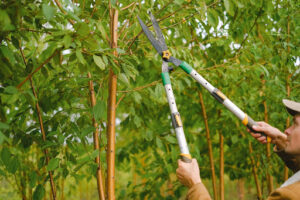
A Comprehensive Guide to Spring Tree Trimming in Dallas, Texas: Tips and Techniques for a Healthy Landscape
Date May 01, 2023
Spring has sprung in Dallas, Texas, and that means it’s time for tree trimming. Homeowners can be the envy of the neighborhood with this comprehensive guide, which provides tips and techniques for creating a beautiful and healthy landscape.
What To Cut
Image via Pexels by Anna Shvets
Most trees need occasional trimming. The first step is to gather the equipment. A pair of bypass loppers work well for small branches and make a clean cut that allows the tree to heal quickly. Grab a handsaw or chainsaw for larger branches, then trim dead limbs with anvil loppers. Aim to trim between 5% and 10% of the tree. Cut branches that are dead, hazardous, damaged, or weak. Plan to remove any sucker branches that may have sprouted from the trunk.
How To Cut a Tree Branch
The ideal spot for removing a branch is 8 to 12 inches above the collar or where the limb joins the tree. First, make a clean, downward-angled cut. This enables the tree to form a callus, which will protect it from sickness and infestation. Next, for branches larger than 1 inch in diameter, make three cuts to ensure the trimming doesn’t harm the tree, and follow these steps:
1. Start by cutting halfway through the underside of the branch. This undercut prevents the limb from ripping down or damaging the trunk.
2. Then, about 3 to 4 inches past the undercut, cut all the way through to remove the branch.
3. For the final step, cut all the way through the outside of the tree collar for a clean edge and a short stub.
What Not To Do
Trimming trees correctly is important. Try to avoid tearing or harming the trunk, as trees are living creatures that can sustain trauma by improper trimming. Make sure to avoid the following:
- Cutting branches that grow straight up.
- Leaving too long of a stub.
- Trimming too close to the tree.
- Removing more than 25% of a live tree.
- Raising the canopy too high by cutting off the big lower branches.
- Reducing large trees to just two or three limbs.
Examine Trees for Health Issues
After trimming the dead branches and suckers, inspect the tree for common problems. For example, fruit trees, such as ornamental pears, are susceptible to fire blight. The bark may appear charred and the leaves wilted. In addition, Texas oak trees can show symptoms of oak wilt, such as fungal mats. This problem, which can kill oaks, has reached epidemic proportions in Texas, so it’s vital to catch it in the early stages to preserve the tree.
Diseased limbs should be carefully removed, so the disease doesn’t spread to other parts of the tree. Remember to wipe off tool blades with rubbing alcohol before touching healthy branches. Immediately remove any sick branches from the area or consider burning them.
Tree trimming is something the average homeowner can do with the right tools. Always follow safe practices and never trim trees near a power line. If you have questions or want the help of an expert, call TreeNewal today.









